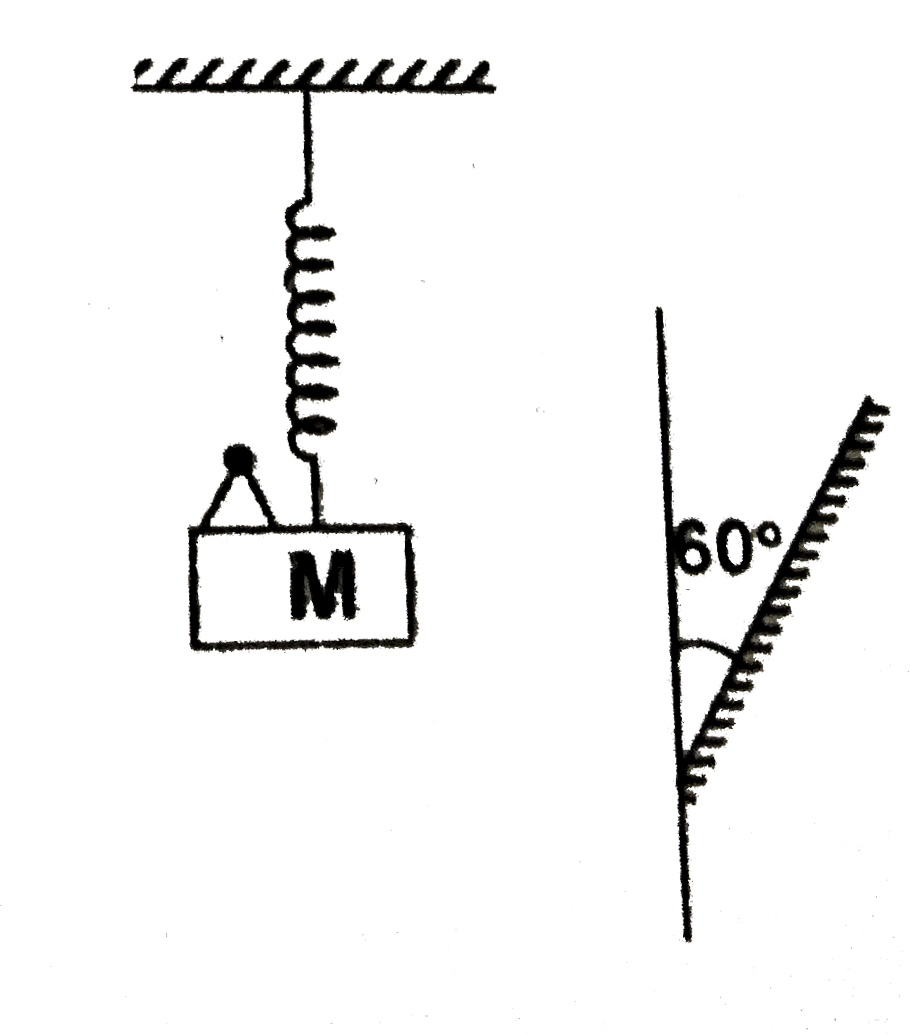The mass (M) shown in the figure oscillates in simple harmonic motion with amplitude of the point (P) is.
(##JMA_CHMO_C10_010_Q01##).
k1Ak2
k2Ak1
k1Ak1+k2
k2Ak1+k2
The correct Answer is:D
In series force remain same, if extension in k1 and k2 are x1 and x2 respectively.
Then k1x1=k2x2⇒x1+x2=A
⇒x1+k1x1k2=A⇒x1k1+k2k2=A
⇒x1=k2A(k1+k2)
Amplitude of point P will be the max, ext. in k1.
So amplitude of point P is k2Ak1+k2
Topper's Solved these Questions
- BOOK - ALLENCHAPTER - SIMPLE HARMONIC MOTIONEXERCISE - MCQ s one or more than one correct answers5videos
SIMPLE HARMONIC MOTION
- BOOK - ALLENCHAPTER - SIMPLE HARMONIC MOTIONEXERCISE - Match The Column9videos
SIMPLE HARMONIC MOTION
- BOOK - ALLENCHAPTER - SIMPLE HARMONIC MOTIONEXERCISE - Exercise-05 [A]39videos
SIMPLE HARMONIC MOTION
- BOOK - ALLENCHAPTER - RACEEXERCISE - Basic Maths (Wave Motion & Dopplers Effect) (Stationary waves & doppler effect, beats)25videos
RACE
- BOOK - ALLENCHAPTER - TEST PAPEREXERCISE - PHYSICS4videos
TEST PAPER
Similar Questions
The figure shows a mass M attached to a series arrangement of two springs of spring constants k1andk2 where k2=2k1. If the mass M oscillates in simple harmonic motion with amplitude A, the amplitude of the point O is αAβ. Find β−α.
 View Solution
View SolutionThe graph below shows a particle in simple harmonic motion. From the information shown, find the value of time t1(in S).
'(##CEN_KSR_PHY_JEE_C16_E01_010_Q03##)'View Solution
Knowledge Check
- Question 1 - Select One
The mass M shown in figure ocillates in simple harmonic motion with amplitude A.
The amplitude of the point P is
 Ak1Ak2Bk2Ak2−k1Ck2Ak1+k2Dk2Ak1
Ak1Ak2Bk2Ak2−k1Ck2Ak1+k2Dk2Ak1 - Question 2 - Select One
The mass M shown in the figure oscillates in simple harmnonic motion and amplitude A. The amplitude of the point P is
 Ak1Ak2Bk2Ak1Ck1Ak1+k2Dk2Ak1+k2
Ak1Ak2Bk2Ak1Ck1Ak1+k2Dk2Ak1+k2 - Question 3 - Select One
The mass M shown in the figure oscillates in simple harmonic motion with amplitude A. The maximum speed of junction P is V0. Assume springs are massless. Select the correct option/s
 AAmplitude of potential energy is springs S1 and S2 is respectivley 19kA2 and kA2BAmplitude of potential energy is S1 and S2 is respectively 29kA2 and 19kA2CV0=A√8k27MDV0=A√8k81M
AAmplitude of potential energy is springs S1 and S2 is respectivley 19kA2 and kA2BAmplitude of potential energy is S1 and S2 is respectively 29kA2 and 19kA2CV0=A√8k27MDV0=A√8k81M
A particle executes simple harmonic motion of amplitude A. At what points is its speed half the maximum speed ?
View SolutionA ball is rolling without slipping in a spherical shallow bowl (radius R) as shown in the figure and is executing simple harmonic motion. If the radius of the ball is doubled, the period of oscillation
 View Solution
View SolutionThe amplitude of given simple harmonic motion is y=(3sinωt+4cosωt)m
View SolutionA particle of mass 10grams is executing simple harmonic motion with an amplitude of 0.5 m and periodic time of )(π/5)seconds . The maximum value of the force acting on the particle
View Solution
An insect of negligible mass is sitting on a block of mass M, tied with a spring of force constant k. the block performs simple harmonic motion with amplitude A in front of a plane mirror placed as shown in the figure the maximum speed of insect relative to its image will beView Solution

